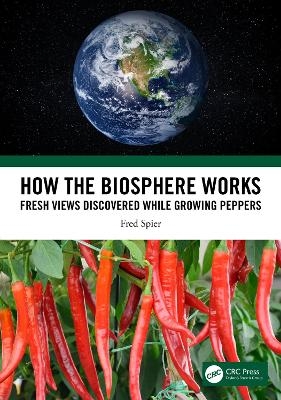
How the Biosphere Works
CRC Press (Verlag)
978-1-032-23040-5 (ISBN)
How the Biosphere Works: Fresh Views Discovered While Growing Peppers offers a simple and novel theoretical approach to understanding the history of the biosphere, including humanity’s place within it. It also helps to clarify what the possibilities and limitations are for future action. This is a subject of wide interest because today we are facing a great many environmental issues, many of which may appear unconnected. Yet all these issues are part of our biosphere. For making plans for the future and addressing our long-term survival and well-being, an integrated knowledge of our biosphere and its history is therefore indispensable.
Key Features
Documents what the biosphere is, and what our position as humans within it is today.
Describes how the biosphere has become the way it is.
Summarizes the novel simple theoretical model proposed in the book, and thus, how the biosphere functions.
Predicts what the possibilities and limitations are for future human action
Emphasizes how simple but careful observations can lead to far-reaching theoretical implications.
Fred Spier is senior lecturer in big history emeritus at the University of Amsterdam. He holds a M.Sc. in chemistry (with distinction) as well as a M.A. and Ph.D. in cultural anthropology and social history (both cum laude, the highest distinction in the Netherlands). He has taught big history in various academic settings, while lecturing about it all around the world. He is the author of the highly-acclaimed books Religious Regimes in Peru (1994), for which Spier was awarded a Praemium Erasmianum Study Prize 1993; The Structure of Big History: From the Big Bang until Today (1996); and Big History and the Future of Humanity (2010, 2015). Between 2011 and 2014, Spier was the founding vice president of the Intl. Big History Assn. (IBHA) and its president de facto, and between 2014 and 2016 its second president.
Preface. Chapter One. The Context of Discovery: A Personal Survey of the Natural and Social Sciences Concerning our Biosphere's History. Chapter Two. Cultivating Pepper Plants: Jointly Maximizing the Capture of Solar Energy. Chapter Three. Examining Key Concepts of our Biosphere's History. Chapter Four. What Needs to Be Considered While Writing our Biosphere's History? Chapter Five. A Fresh History of the Biosphere Before Humans. Chapter Six. What are Humanity's General Effects within the Biosphere's History? Chapter Seven. Seven Million Years of Human Influences within the Biosphere's History. Chapter Eight. What About our Long-Term Survival Strategy within the Future Biosphere? Epilogue. Appendix One. A Personal Look at the City of Eindhoven's History. Appendix Two. List of Biases Mentioned in the Book.
| Erscheinungsdatum | 27.04.2022 |
|---|---|
| Zusatzinfo | 1 Tables, black and white; 1 Line drawings, color; 1 Line drawings, black and white; 15 Halftones, color; 34 Halftones, black and white; 16 Illustrations, color; 35 Illustrations, black and white |
| Verlagsort | London |
| Sprache | englisch |
| Maße | 156 x 234 mm |
| Gewicht | 458 g |
| Themenwelt | Naturwissenschaften ► Biologie ► Botanik |
| Naturwissenschaften ► Biologie ► Ökologie / Naturschutz | |
| Weitere Fachgebiete ► Land- / Forstwirtschaft / Fischerei | |
| ISBN-10 | 1-032-23040-1 / 1032230401 |
| ISBN-13 | 978-1-032-23040-5 / 9781032230405 |
| Zustand | Neuware |
| Informationen gemäß Produktsicherheitsverordnung (GPSR) | |
| Haben Sie eine Frage zum Produkt? |
aus dem Bereich


